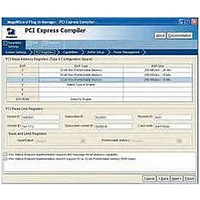IP-PCIE/1 Altera, IP-PCIE/1 Datasheet - Page 336

IP-PCIE/1
Manufacturer Part Number
IP-PCIE/1
Description
IP CORE - PCI Express X1 Lane
Manufacturer
Altera
Type
MegaCorer
Specifications of IP-PCIE/1
Software Application
IP CORE, Interface And Protocols, PCI
Supported Families
Arria GX, Cyclone II, HardCopy II, Stratix II
Core Architecture
FPGA
Core Sub-architecture
Arria, Cyclone, Stratix
Rohs Compliant
NA
Function
PCI Express Compiler, x1 Link Width
License
Initial License
Lead Free Status / RoHS Status
na
Lead Free Status / RoHS Status
na
- Current page: 336 of 362
- Download datasheet (7Mb)
B–30
PCI Express Compiler User Guide
RX Datapath
The RX datapath contains the RX boundary registers (for incremental compile) and a
bridge to transport data from the PCI Express IP core interface to the Avalon-ST
interface. The bridge autonomously acks all packets received from the PCI Express IP
core. For simplicity, the rx_abort and rx_retry features of the IP core are not used,
and RX_mask is loosely supported. (Refer to
details.) The RX datapath also provides an optional message-dropping feature that is
enabled by default. The feature acknowledges PCI Express message packets from the
PCI Express IP core, but does not pass them to the user application. The user can
optionally allow messages to pass to the application by setting the DROP_MESSAGE
parameter in altpcierd_icm_rxbridge.v to 1’b0. The latency through the ICM RX
datapath is approximately four clock cycles.
TX Datapath
The TX datapath contains the TX boundary registers (for incremental compile) and a
bridge to transport data from the Avalon-ST interface to the PCI Express IP core
interface. A data FIFO buffers the Avalon-ST data from the user application until the
PCI Express IP core accepts it. The TX datapath also implements an NPBypass
function for deadlock prevention. When the PCI Express IP core runs out of
non-posted (NP) credits, the ICM allows completions and posted requests to bypass
NP requests until credits become available. The ICM handles any NP requests
pending in the ICM when credits run out and asserts the tx_mask signal to the user
application to indicate that it should stop sending NP requests. The latency through
the ICM TX datapath is approximately five clock cycles.
MSI Datapath
The MSI datapath contains the MSI boundary registers (for incremental compile) and
a bridge to transport data from the Avalon-ST interface to the PCI Express IP core
interface. The ICM maintains packet ordering between the TX and MSI datapaths. In
this design example, the MSI interface supports low-bandwidth MSI requests. For
example, not more than one MSI request can coincide with a single TX packet. The
MSI interface assumes that the MSI function in the PCI Express IP core is enabled. For
other applications, you may need to modify this module to include internal buffering,
MSI-throttling at the application, and so on.
Sideband Datapath
The sideband interface contains boundary registers for non-timing critical signals
such as configuration signals. (Refer to
ICM Files
This section lists and briefly describes the ICM files. The PCI Express MegaWizard
generates all these ICM files placing them in the
<variation name>_examples\common\incremental_compile_module folder.
Table B–17 on page B–36
Table B–14 on page B–32
Incremental Compile Module for Descriptor/Data Examples
December 2010 Altera Corporation
for details.)
for further
Chapter :
Related parts for IP-PCIE/1
Image
Part Number
Description
Manufacturer
Datasheet
Request
R

Part Number:
Description:
IP CORE - 32-bit 66MHz PCI Master/Target
Manufacturer:
Altera
Datasheet:

Part Number:
Description:
IP CORE - 64-bit 66MHz PCI Master/Target
Manufacturer:
Altera
Datasheet:

Part Number:
Description:
IP CORE - 32-bit 66MHz PCI Target
Manufacturer:
Altera
Datasheet:

Part Number:
Description:
IP CORE - 64-bit 66MHz PCI Target
Manufacturer:
Altera
Datasheet:

Part Number:
Description:
IP CORE Renewal Of IP-PCI/MT32
Manufacturer:
Altera
Datasheet:

Part Number:
Description:
IP CORE Renewal Of IP-PCI/MT64
Manufacturer:
Altera
Datasheet:

Part Number:
Description:
IP CORE Renewal Of IP-PCI/T32
Manufacturer:
Altera
Datasheet:

Part Number:
Description:
IP CORE Renewal Of IP-PCI/T64
Manufacturer:
Altera
Datasheet:

Part Number:
Description:
IP CORE - PCI Express X1 And X4 Lanes
Manufacturer:
Altera
Datasheet:

Part Number:
Description:
IP CORE - PCI Express X1 X4 And X8 Lanes
Manufacturer:
Altera
Datasheet:

Part Number:
Description:
IP NIOS II MEGACORE
Manufacturer:
Altera
Datasheet:











